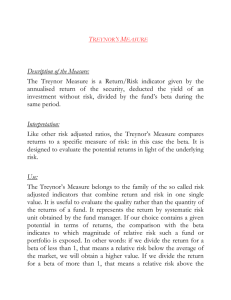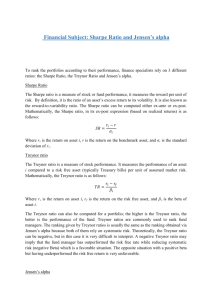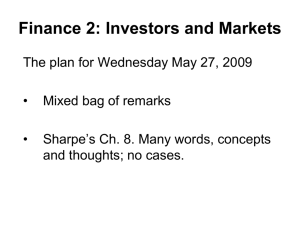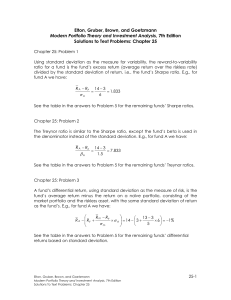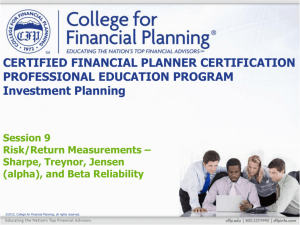Chapter 29 Performance of Mutual Funds Investments
advertisement
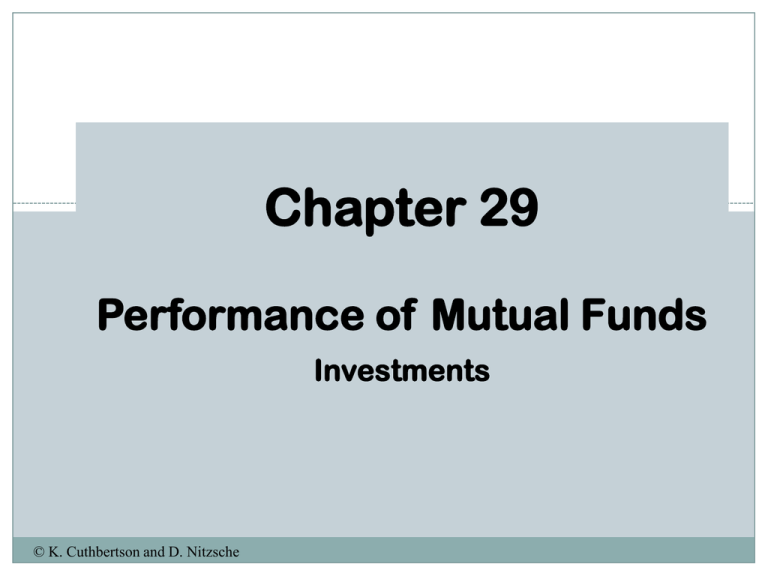
Chapter 29 Performance of Mutual Funds Investments © K. Cuthbertson and D. Nitzsche Learning Objectives To explain how we assess risk-adjusted performance of mutual funds using funds alpha To examine the historic performance of mutual funds To examine whether it is possible to pick groups of funds that earn positive abnormal return in the future To examine whether investors put money in into funds that do well and withdraw from funds that do perform badly © K. Cuthbertson and D. Nitzsche A Lesson from a Few Mutual Funds 3 The two key points with performance evaluation: The arithmetic mean is not a useful statistic in evaluating Consider the historical returns of two mutual funds on the following slide A Lesson from a Few Mutual Funds (cont’d) 4 Year 44 Wall Street Mutual Shares Year 44 Wall Street Mutual Shares 1975 184.1% 24.6% 1982 6.9 12.0 1976 46.5 63.1 1983 9.2 37.8 1977 16.5 13.2 1984 –58.7 14.3 1978 32.9 16.1 1985 –20.1 26.3 1979 71.4 39.3 1986 –16.3 16.9 1980 36.1 19.0 1987 –34.6 6.5 1981 -23.6 8.7 1988 19.3 30.7 Mean 19.3% 23.5% Change in net asset value, January 1 through December 31. A Lesson from a Few Mutual Funds (cont’d) 5 Ending Value ($) Mutual Fund Performance $200,000.00 $180,000.00 $160,000.00 $140,000.00 $120,000.00 $100,000.00 $80,000.00 $60,000.00 $40,000.00 $20,000.00 $- 44 Wall Street Mutual Shares 7 19 7 8 19 0 8 19 Year 3 8 19 6 A Lesson from a Few Mutual Funds (cont’d) 6 44 Wall Street and Mutual Shares both had good returns over the 1975 to 1988 period Mutual Shares clearly outperforms 44 Wall Street in terms of dollar returns at the end of 1988 Why the Arithmetic Mean Is Often Misleading: A Review 7 The arithmetic mean may give misleading information e.g., a 50 percent decline in one period followed by a 50 percent increase in the next period does not produce an average return of zero Why the Arithmetic Mean Is Often Misleading: A Review (cont’d) 8 The proper measure of average investment return over time is the geometric mean: 1/ n GM Ri 1 i 1 where Ri the return relative in period i n Traditional Performance Measures 9 Sharpe Measure Treynor Measures Jensen Measure Performance Measurement in Practice Sharpe and Treynor Measures 10 The Sharpe and Treynor measures: Sharpe measure Treynor measure R Rf R Rf where R average return R f risk-free rate standard deviation of returns beta Sharpe and Treynor Measures (cont’d) 11 Example Over the last four months, XYZ Stock had excess returns of 1.86 percent, –5.09 percent, –1.99 percent, and 1.72 percent. The standard deviation of XYZ stock returns is 3.07 percent. XYZ Stock has a beta of 1.20. What are the Sharpe and Treynor measures for XYZ Stock? Sharpe and Treynor Measures (cont’d) 12 Example (cont’d) Solution: First, compute the average excess return for Stock XYZ: 1.86% 5.09% 1.99% 1.72% R 4 0.88% Sharpe and Treynor Measures (cont’d) 13 Example (cont’d) Solution (cont’d): Next, compute the Sharpe and Treynor measures: Sharpe measure Treynor measure R Rf R Rf 0.88% 0.29 3.07% 0.88% 0.73 1.20 Portfolio Performance Measures: Treynor’s versus Sharpe’s Measure Treynor versus Sharpe Measure Sharpe uses standard deviation of returns as the measure of risk Treynor measure uses beta (systematic risk) Sharpe evaluates the portfolio manager on basis of both rate of return performance and diversification Methods agree on rankings of completely diversified portfolios Produce relative not absolute rankings of performance Jensen Measure 15 The Jensen measure stems directly from the CAPM: Rit R ft i Rmt R ft Jensen Measure (cont’d) 16 The constant term should be zero Securities with a beta of zero should have an excess return of zero according to finance theory According to the Jensen measure, if a portfolio manager is better-than-average, the alpha of the portfolio will be positive Academic Issues Regarding Performance Measures 17 The use of Treynor and Jensen performance measures relies on measuring the market return and CAPM Difficult to identify and measure the return of the market portfolio Evidence continues to accumulate that may ultimately displace the CAPM Arbitrage pricing model, multi-factor CAPMs, inflationadjusted CAPM Industry Issues 18 “Portfolio managers are hired and fired largely on the basis of realized investment returns with little regard to risk taken in achieving the returns” Practical performance measures typically involve a comparison of the fund’s performance with that of a benchmark Industry Issues (cont’d) 19 “Fama’s return decomposition” can be used to assess why an investment performed better or worse than expected: The return the investor chose to take The added return the manager chose to seek The return from the manager’s good selection of securities 20 Industry Issues (cont’d) 21 Diversification is the difference between the return corresponding to the beta implied by the total risk of the portfolio and the return corresponding to its actual beta Diversifiable risk decreases as portfolio size increases, so if the portfolio is well diversified the “diversification return” should be near zero Industry Issues (cont’d) 22 Net selectivity measures the portion of the return from selectivity in excess of that provided by the “diversification” component
